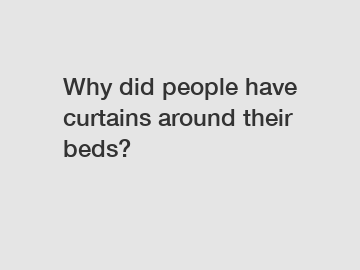Why did people have curtains around their beds?
Why did people have curtains around their beds?
Throughout history, people have utilized curtains around their beds for various reasons. In different periods and cultures, bed curtains served numerous functions beyond mere decoration. From providing privacy and warmth to symbolizing social status, these curtains played a significant role in the lives of individuals. This article explores the historical significance of bed curtains and the reasons why people chose to surround their beds with these unique fabric enclosures.
Functionality and Privacy.

One of the primary purposes of bed curtains was to maintain privacy. In past centuries, multi-purpose living spaces were common, and beds were often placed in rooms that were shared with other family members or servants. By enclosing the bed with curtains, individuals could ensure a private space, shielded from prying eyes. This allowed for more personal comfort and intimacy in shared living environments.
Warmth and Comfort.
In colder climates, bed curtains served as a practical tool to keep warm during chilly nights. The fabric enclosure created a barrier against drafts and helped retain body heat. In regions where fireplaces or heating systems were not readily available, bed curtains became an essential element for warmth and comfort during sleep. The heavy fabric would minimize temperature fluctuations, providing a cozy and snug sleeping environment.
Protection from Insects and Dust.
In times when hygiene standards were different from today, keeping insects, dust, and dirt away from the sleeping area was crucial for maintaining personal health. By surrounding the bed with curtains, individuals could protect themselves from bugs, mosquitoes, and other pests that were prevalent in many societies. Furthermore, the curtains provided a barrier against airborne particles, reducing the exposure to dust and dirt commonly found in older, less sanitary living conditions.
Symbol of Social Status.
In certain societies, bed curtains served as a symbol of social status. Wealthier individuals or high-ranking members of the society often had ornate, intricately designed curtains, showcasing their affluence and sophistication. The quality of materials, embroidery, and decorative elements used in bed curtains indicated the wealth and societal standing of the bed's owner. Thus, bed curtains became an art form representing one's prominence in the community.
Today's Adaptations.
While bed curtains may not be as common nowadays, their legacy can still be seen in various adaptations. Canopy beds, for instance, exhibit a similar concept of enclosing the sleeping area, albeit without the heavy fabric drapes. Canopies add a touch of elegance and luxury to modern bedrooms while providing a sense of privacy and coziness. Additionally, certain cultural traditions, such as mosquito nets in tropical regions, echo the idea of using fabric to protect individuals during sleep.
Conclusion.
Throughout history, bed curtains served not only practical purposes but also held symbolic significance. From guaranteeing privacy in shared spaces to providing warmth and protection from insects, these fabric enclosures played an essential role in people's lives. Today, while bed curtains may no longer be prevalent, their influence can be seen in various adaptations that have evolved over time. Whether for functional or decorative reasons, the use of curtains around beds has left a lasting impression on the way we perceive and design our sleeping spaces.
If you have any questions or want to learn more about the history of bed curtains, please feel free to contact us.
Are you interested in learning more about custom silver conductive fabric supplier, faraday fabric wholesale, silver mesh fabric? Contact us today to secure an expert consultation!

Comments
0